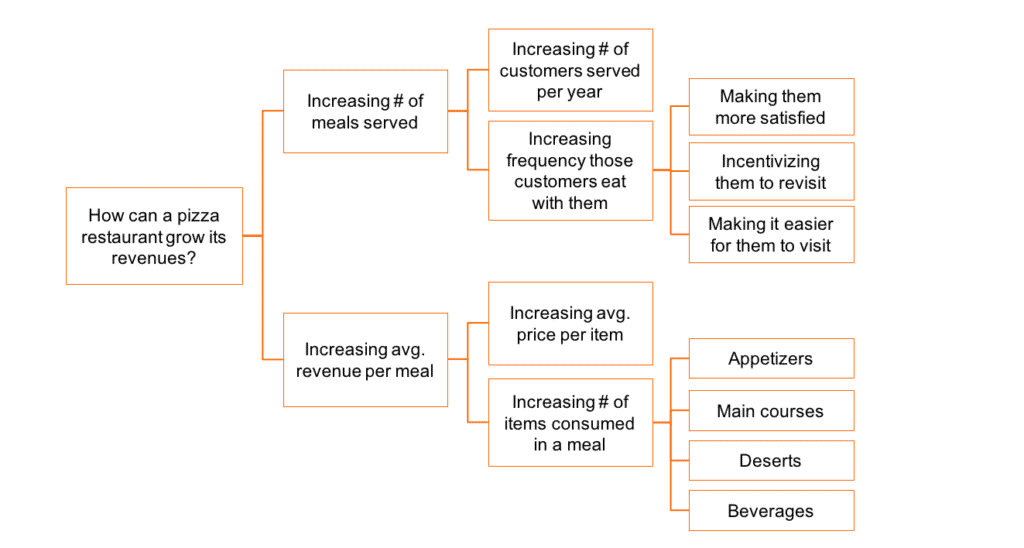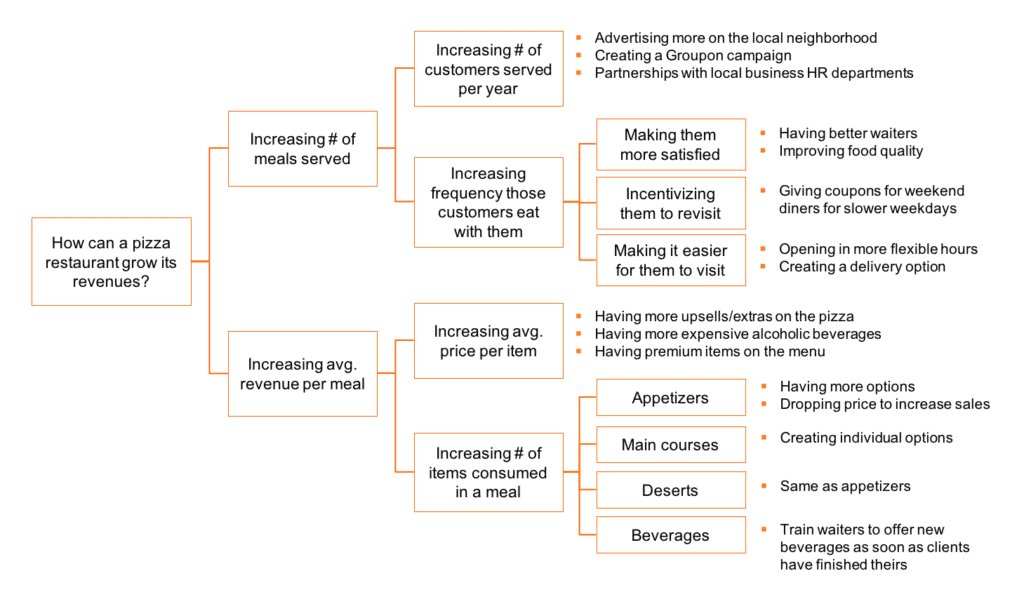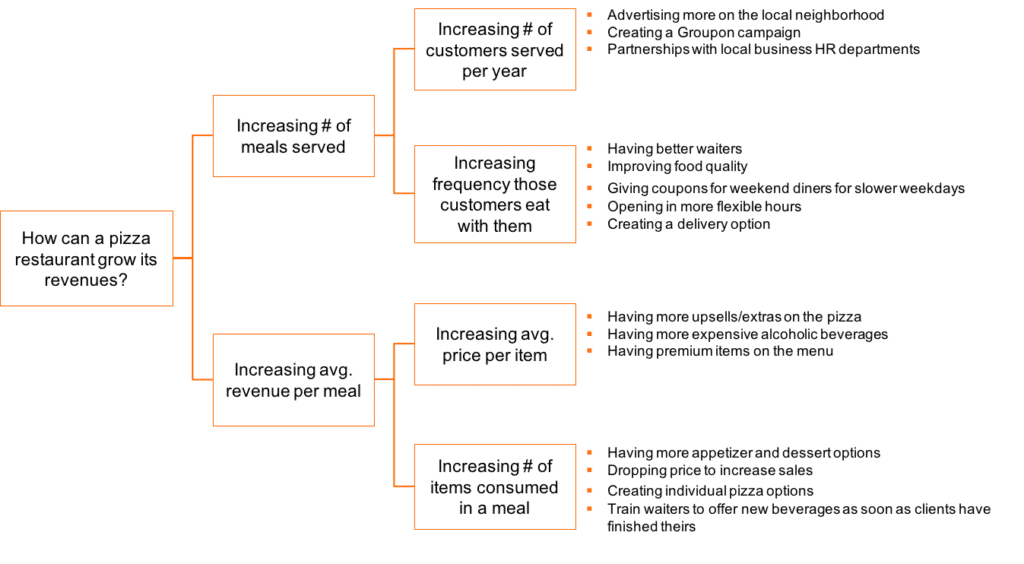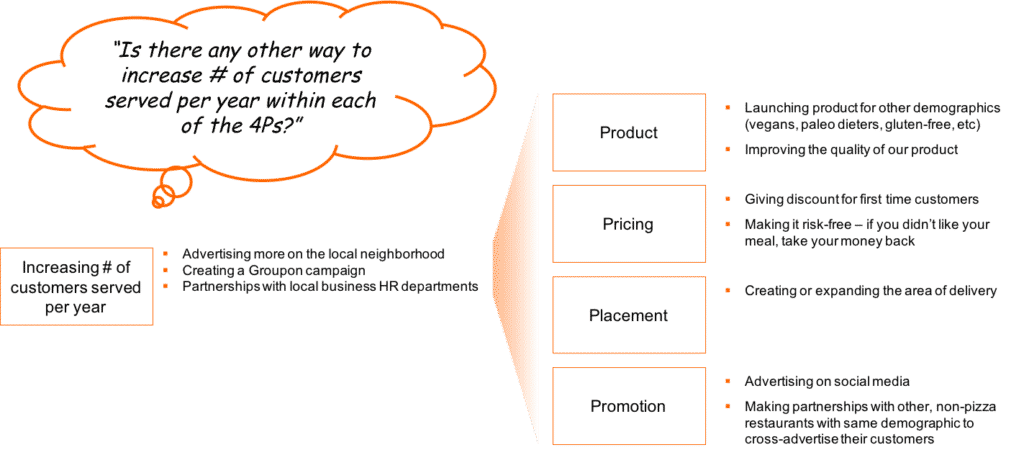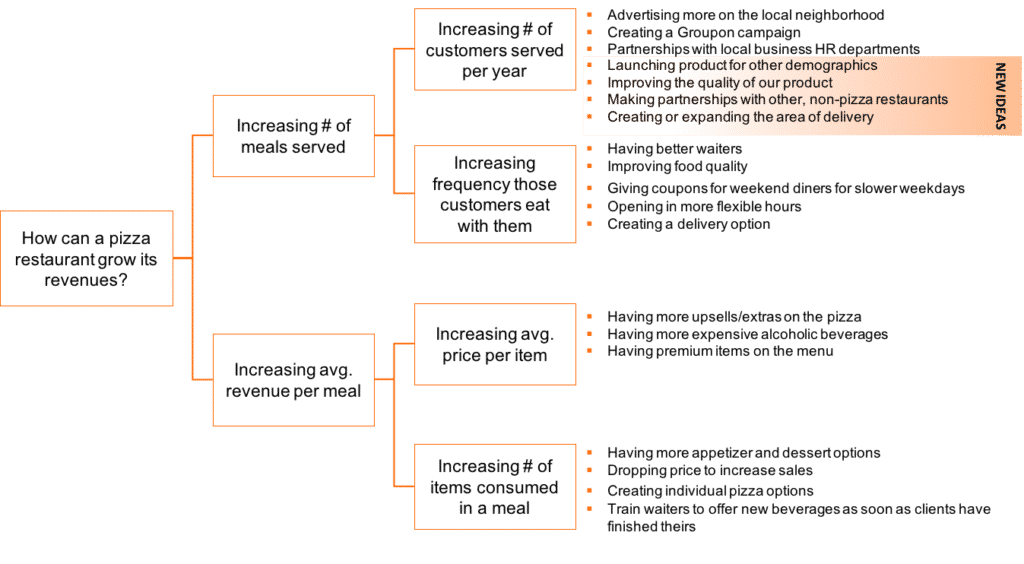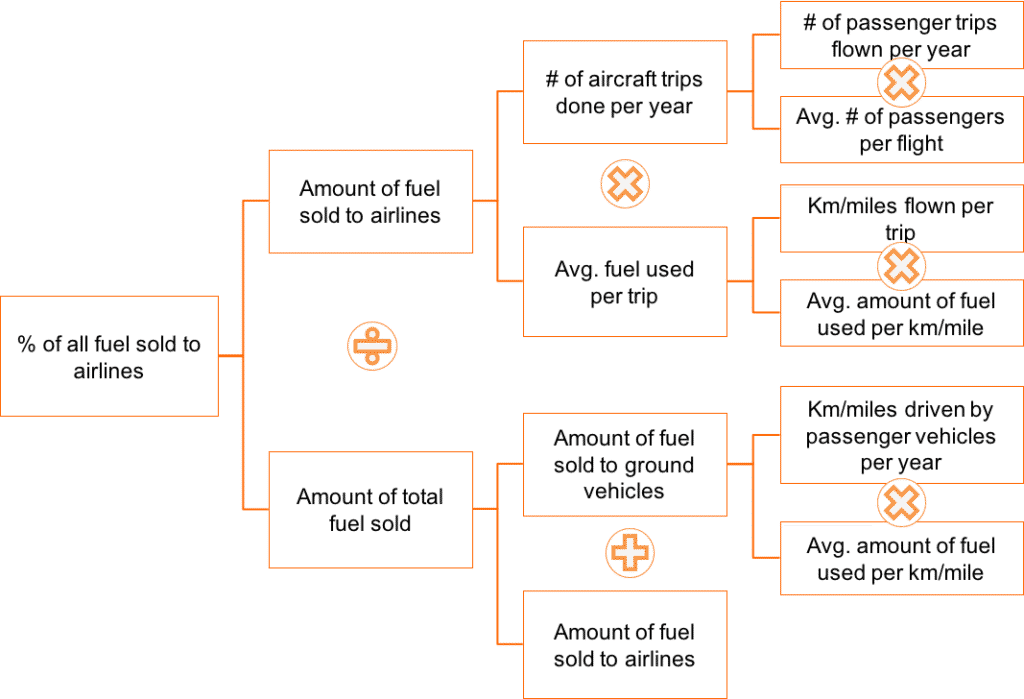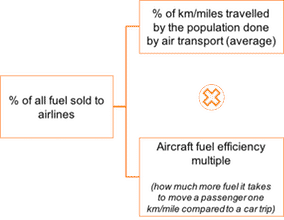You want to be creative when solving your case interviews, don’t you?
Of course you do!
It’s one of the best ways to differentiate yourself as a candidate AND as a working consultant.
But maybe you’ve never seen yourself as a creative person.
Maybe you were always the “analytical guy (or gal)”.
Or maybe you can come up with a few good ideas to any problem, but never more than that – your list is always shorter than you wish it were.
Heck, I always thought of yourself a creative person, but the first time I applied to McKinsey my interviewer told me I was actually falling short in that department. I was then left wondering how the hell I could improve it.
So, how can you get more creative in your case interviews?

Ehh, probably not...
When candidates ask that question, what they usually get is a generic answer that ranges from “just try to think more broadly” to the seemingly insightful “you should read more books and articles on business”.
The problem?
Well, the first tip is not even a tip.
The second one may work, but it would take months if not years to really improve your business sense by “reading books and articles”.
And you don’t have that much time.
The problem with those two tips is that they’re not actionable enough.
It’s as if management consultants told their clients that they would improve their business performance if they just “managed their company better” and “invested more in their people”.
Of course these things would improve a company’s performance!
But these are also the types of recommendations that leave you wondering what specifically should you do tomorrow.
And they also leave you thinking if they would ever work for you, a “non-creative person”.
I’m NOT gonna give you any generic tips like those in this article.
Instead, I’ll give you 11 highly actionable, widely tested techniques that you’ll be able to use to be more creative in your very next case.
Oh, and by the way… These techniques work even if you don’t consider yourself a “creative person”.
But first, a word of warning...
ALWAYS USE STRUCTURE TO GENERATE IDEAS AND HYPOTHESES!
Before we get to the tips I need to warn you of a common mistake first.
You might know that you always need to be structured in your consulting case interviews.
But did you know you also have to be structured even when being creative?
In fact, as we teach in our free course on case interview fundamentals, there’s a whole type of question dedicated to test your creativity in case interviews: the Brainstorming question.
And while the Brainstorming question is there to test your abilities to generate good, creative ideas and hypotheses for your cases, it is testing first and foremost your ability to be structured when generating those ideas and hypotheses.
Why?
The short answer is that consultants are always structured when doing anything.
The long answer can be found in the Brainstorming module of our free course, but it has to do with the fact that when your ideas are in a structured format, you’re able to test them much more efficiently.
As a consultant, you’re not paid to simply generate ideas…
You’re paid to generate GOOD ideas.
And how do you know your ideas are good?
Well, you TEST your ideas and PROVE they’re good.
(Also, as you’re gonna see in the first two tips, having structure can help you be even more creative when generating ideas.)
So, always have a MECE structure to generate ideas or hypotheses when doing cases.
If you have difficulty creating these MECE structures, you can check out our article on the 5 Ways to be MECE.
Now that you’re know you’ll always be structured when generating ideas and hypotheses, let’s move on to the 11 highly actionable tips and techniques you can use to be more creative!
Pro tip: Each idea in this article can 2X how creative in you are in case interviews – pick just one or two and practice it before coming for more!
Tip #1. Dig deeper in your structures to generate more ideas
Most people think having a structure will make them “more rigid” and less creative.
In fact it’s the opposite.
Structures only restrict you when you’re force-fitting them into a problem. When you create a structure customized enough for the problem (as in when using the 5 Ways to be MECE), these structures enhance your creativity.
And the interesting thing is that making your structures deeper may help you even more.
Why?
Because now you have more “buckets” or categories of ideas to stimulate your thinking.
Just think about it…
Suppose you had to generate ideas on how a pizza restaurant can increase revenues and you had this structure:
It’s hard to generate more than a few ideas per bucket, right?
And if you did that, you’d get about 6 ideas.
That’s not enough to impress any interviewer (or client, for that matter).
Now, imagine you had the same problem but you had this structure to work with instead:
Can you generate at least 15 ideas now?
Of course you can! There are 9 buckets at the end of the tree.
A deeper structure helps you be more creative due to simple math: if you can generate 5 ideas per bucket, you’ll have at most 10 ideas using the first structure, but you can get to up to 45 ideas using the second one.
Number of ideas isn’t the only factor interviewers use to evaluate how creative a candidate is, but it one important factor nevertheless.
Which is one reason why MBB interviewers incessantly ask “what else?” in an eternal push to see how many ideas do you have under your belt.
Here are some ideas I’ve generated using the second structure. Look at how creative I can get because I’m digging into the specifics of how a pizza restaurant can generate more revenues:
Knowing that more structure leads to more ideas and greater creativity can be an incredible advantage you have over other candidates. The reason why it’s an advantage is that this is a counterintuitive idea.
Most people think of creativity as less structure and more “free thinking”, whatever that means.
But that’s nonsense!
Even artists have structure – screenwriters have plot types, painters have different types of canvases and materials. And what are art genius if not an artist who has figured out a new type of structure to work with?
So if more structure leads to more creativity, are there other ways to have more structure if not going deeper on your structure? Yep. I’ll show you how on tip #2…
Tip #2. Create alternative, "back-in-your-head" structures to generate even more ideas
As everyone well versed in the 5 Ways to be MECE knows, there is more than one way to structure any problem.
In fact, there’s often dozens of different ways to structure a problem. You can create multiple structures using each of the 5 ways to be MECE for most business problems.
And different structures lead your mind into generating different ideas.
For example, in the last example we used a “# of meals * avg. revenue per meal” structure to describe how a pizza restaurant could generate more revenues.
And this led us to generate all sorts of different ideas.
However, we could’ve adapted the 4Ps of marketing to structure that problem as well.
We could have asserted that we can increase revenues by changing something related to “Product, Pricing, Placement or Promotion”. (These are the 4Ps of marketing for those without a business background, by the way).
Now, don’t get me wrong: you CANNOT use both structures at the same time. You have to pick ONE way to structure the problem, otherwise you’ll create a lot of overlap in your structure and fail the MECE principle.
But you can acknowledge the possibility of this alternative structure in the back of your head and use this awareness to bulletproof your idea generation.
The way to do it?
Simple, use the secondary structure as a “checklist” to see if you’ve got all good ideas related to Product, to Pricing, to Placement and to Promotion in the previous structure.
Here’s how to do it…
First, you start with your primary structure. For this example I’m just going to use a simplified version of the structure from Tip #1 with all the same ideas:
Then you go through each bucket from your primary tree and think if there are any ideas within Product, Pricing, Placement and Promotion that you might have missed in the original structure.
This all happens in your head. Let me show you how the thinking process is like for the first bucket of the previous structure:
And while you’re having these ideas using your “secret” structure in the back of your head, you can add the best ones to your original issue tree and talk through them to your interviewer.
Here’s the original issue tree with the ideas I like the best added to it:
The next step would be to go through the other buckets and do the same exercise.
You can easily 2X or even 3X the number of good ideas you can generate by using another structure as secondary structure on the back of your head.
Different structures lead to different ideas and hypotheses.
Oh, and by the way, you don’t have to stop with ONE “back-in-your-head” structure.
After you’ve used one, you can create another alternative structure and repeat the process.
Because different structures look at the same problem from a different angle, you’ll always be able to find more ideas and hypotheses when you use this technique.
(And just to be clear, you’re always using these alternative structures in the back of your head – you could but don’t have to make your interviewer aware that you’re doing this, and you should NEVER switch structures unless your initial one was actually not good at solving the problem).
Now, if you’re thinking this whole article is going to be about structuring, you’re wrong.
Structuring does help with creativity.
However, I understand sometime being creative is a more “right-brained” kind of exercise.
And if you’re great at structuring and want to use my first couple of tips, those are gonna be golden!
But what if you suck at structuring?
Well, then I think you’ll love technique #3. Especially if your business sense is quite good…
Tip #3. Use the "industry analogy technique" to come up with better issues and hypotheses
This one’s by far my favorite.
It is also my secret weapon to be smart and insightful about weird/uncommon industries I didn’t even know existed before. I used it all the time at McKinsey to add value to a project from day 1.
(And I still secretly use it when talking to friends about the industries they work in and I’m often able to pinpoint issues with their businesses they didn’t even know about.)
Here’s how the technique works…
Imagine you had a case where your goal was to think of ways to make an airline cargo company more efficient.
How would you do that?
Surely you can use a generic “efficiency framework” to break that problem down and that may help.
But still, how can you come up with fresh insights from an industry you know nothing about?
Enter the “industry analogy technique”.
What you do is to look for similar yet simpler industries that you know more about.
So, you may know nothing about air cargo, but I’m sure you’ve seen trucks in the road before. You might even have met a trucker before, or dealt with logistics providers in a former job.
What are some ideas you’d have in order to make a trucking company more efficient?
Most of them will still work with airline cargo.
Also, I’m sure you’ve flown in passenger airlines before. Many of the efficiency ideas for that could work with airline cargo too. People are just a special type of cargo, after all (or so it seems when you fly certain types of airlines!).
So, you can use this technique in 3 steps:
Step #1: find 1-3 industries that are simpler, yet similar to the one you’re studying.
Step #2: find ideas that would work in those industries.
Step #3: reality check whether those ideas could work in the specific industry you’re looking at.
This third step is especially important because without doing this “reality check”, you’re gonna say things that don’t make sense (such as that calibrating the airplane’s tires better is a good way to improve fuel efficiency in the air cargo industry just because it is indeed a way to do it in the trucking industry).
Anyway, even though you have to use analogies carefully, this technique gives you superpowers.
For example, if I am to study the cruise ship industry (which I know very little about), I can think of this industry as a blend between the maritime shipping industry (which is just a fancier “trucking” industry) and the hotel industry.
Or if I had to come up with the critical issues for the asteroid mining industry, an industry that doesn’t even exist yet, I can do that as well…
Asteroid mining seems like a mixture between the mining industry and the aerospace industry. And the aerospace industry is a very high-tech airline.
Now, before you disagree with me…
If you’re a hyper-rational type you may be looking at all this and thinking “OMG, this doesn’t make any sense – this guy is skipping so many important nuances I can’t even count them!!!”.
And I agree with you!
But that’s the whole point of the exercise – skipping the nuances that you might now know of and getting to the essence of the problem.
(While also being aware there certainly are important nuances that you’re skipping and being humble enough to accept that fact).
The first three techniques were what I call “hard” techniques.
Not because they’re difficult, but because they actually involve actual steps you need to take to be more creative with a specific problem. They’re more “technical”.
The next few techniques are “softer” techniques. All they require is a change in perspective.
If you have more time in your hands and you really want to master this creativity thing, focusing on techniques 1-3 is the way to go.
But if you just want to find quick ways to be more creative in your very next case then stick with me as the next few tips will be highly effective at that.
Tip #4. Use Charlie Munger's "inversion technique"
Charlie Munger is Warren Buffet’s partner.
He’s also a big proponent of what he calls “elementary, worldly wisdom”.
And one of the best techniques he has to solve business problems is what he calls “inversion”.
It basically means looking at the problem from its opposite. Instead of thinking “how to life longer”, think “how not to die”. Instead of thinking “how to get richer”, think “how not to lose money”.
And you can use the inversion technique for case interviews as well.
Say you get a Brainstorming question on how to be more efficient. One way to approach it is “how not to be inefficient” or “what inefficiencies can I get rid of”.
Or say you have a case on how to make customers happy. One way to approach it is “how not to piss off customers”. Many telecom companies would benefit if they thought of it that way.
Or if you need to figure out how to create a great corporate culture… Why not start with “how to avoid having a toxic culture”? (Again, we wouldn’t have Dilbert if companies thought of it that way!).
Inversion won’t solve all of your problems. But for such a simple technique, there’s a lot of bang for its buck.
Tip #5. Think about the problem from the perspective of the other side of the table
This one is kind of like inversion, but instead of thinking the opposite, it’s about thinking from the other side of the table.
Many business problems have another side:
- A sales problem to you is a purchasing problem to whoever’s buying your product.
- A hiring problem to you is a “getting a good job” problem to your prospective hires.
- A “market entry” problem for you is a “new entrant” problem to whoever’s in the market.
- A “should I acquire company X” problem to you is a “should we sell the company” to company X.
Seeing the problem from the other side of the table is a quick way to find more ideas and be more insightful.
It also shows empathy to your interviewer, a highly sought out skill by consulting firms, and a skill they can barely test before you get hired.
For instance, if you want to increase salesforce productivity, it’s easy to think about new sales tactics and techniques, new scripts your sales people can use and ways to decrease how much time they spend on the road.
But if you think from the side of the customer who’s buying your product… What would make they buy faster and giving you less work?
Well, you offering them a product or service that is great, that tackles their exact needs and that they clearly understand how it’s gonna help them.
You can think the same way in different types of problems.
Another example: if you’re considering to enter a market and want to generate hypotheses of what are the risks of entering this market, think about it from the other side of the table…
If you were your competitor in this market and your company entered the market, how would you react?
The last couple of techniques showed you you can get more creative by simply “inverting” a problem.
But there’s one source of “inversion” that rarely gets talked about.
And it’s one that consultants use every single day at work.
Ever heard of that saying that consultants are hired to get your watch and tell you what time it is?
Well, there’s a certain truth to it. Consultants do get opinions from different people from within the organization. They do get ideas and hypotheses from every critical person in every important department of the company to the specific problem they’re solving.
And although I mostly disagree with the saying that consulting is merely watch reading (from my experience it’s more like getting a thousands watches, all of which disagree with each other and telling which one is correct)…
I think it’s pretty clever that consultants start every project talking to all the main stakeholders, as each has a different point of view about the problem.
And even though you can’t really interview clients and ask them questions during your case interviews, you can use the same line of reasoning to be much more creative in your cases.
How?
With tip #6, of course!
Tip #6. Think about the problem from the perspective of different business functions of your client company
This is a cool one that shows a TON of business sense.
And just like Tip #5, it also shows empathy.
Just think about the problem from the perspective of how different business functions within your business would solve the problem.
Let’s go back to the air cargo company that wants to improve efficiency…
What are some ideas the pilots would have to improve efficiency?
Probably a lot of things related to specific maneuvers in taking-off, flying and landing the aircraft. Or things related to how the routing system is set-up. And maybe technical aspects of the fuel and systems your airplanes are using.
But how would the same problem be seen by an air traffic controller?
Well, they might know that certain airports are always delayed and/or always have weather issues and thus should be avoided. Or they might suggest you to focus your cargo deliveries to certain hours of the day or days of the week because those are the least busy.
And how about you have this problem to the marketing and sales department? How would they tackle it?
They’d probably be hyper-aware of certain customers that always change delivery dates and have specific last minute requests. Or customers who might send the wrong cargo to the wrong place. Or that mess up with the packaging and then you have to repackage what they send and that tends to delay your flights.
You can still look at this same problem from a variety of different angles: the maintenance people, the guys who load and unload the aircraft, your customer support staff, even your suppliers.
Looking at the problem from all the different angles people within your business might have is a great way to generate that insightful nugget that will make your interviewer know you’d be a great consultant.
Why?
Because it shows them you’d know who to ask which questions within the client organization.
It doesn’t guarantee you’ll capture all insightful ideas, though.
Many problems happen in the interface of these different business functions and are blindspots to everyone in the organization. Consultants have a dual role of finding out who’s right and finding out if no one’s right, if that’s the case.
Even still, this technique does help a lot in case interviews and real projects alike!
We’ve explored a few ways to be more creative by using what I call “perspective shifting”.
Charlie Munger’s inversion technique “inverts” the problem into its opposite. You can also invert the problem and see it from the other side of the table, and you can flip the problem inside out and see it from the perspective of different people within your organization.
But is inversion the only way to shift perspective?
Not quite!
While inversion shifts the “angle of perspective”, the next two techniques help you be more creative by shifting the “scope of perspective”…
Tip #7. Eliminate all constraints and try to find solutions as if you had unlimited resources
Some constraints are false. They’re imaginary.
Others are real, but eliminating them may help you think of the problem in different ways.
So, remember the task of increasing revenues for the pizza restaurant from the beginning of this article?
We’ll now generate even more ideas that weren’t generated in the first couple of techniques by eliminating constraints:
What if you didn’t have to sell pizza?
You could include more items and other types of cuisines to the menu. Perhaps other Italian dishes, maybe even bread? Couldn’t you become a Italian bakery during the mornings, when the kitchen’s not being used?
What if you weren’t necessarily a restaurant?
Couldn’t you leverage your brand and sell frozen pizza to your customers or even in grocery stores?
What if you weren’t ONE restaurant?
How about expanding and becoming the next Domino’s?
What if you didn’t have a limitation in your culinary expertise?
Maybe you could come up with chef-grade recipes for your pizzas so they become unique? Could you become the next Michelin 3-star pizzeria?
What if you didn’t have a limitation on the number of tables you have in your restaurant? How could you increase revenues then if you could serve all the demand you could get?
You get the idea…
Going wild can help you unleash great ideas. Just make sure you go wild in your mind, otherwise you’ll sound unstructured and lose your offer for that reason.
Changing the scope of perspective works wonders.
Going wild and taking the restrictions down, if only for a moment, as a thought experiment, is one way MBB consultants help their clients reimagine their businesses.
But the magic thing about shifting perspective is that it helps you be more creative no matter how you shift it.
What does that mean?
That if expanding the scope of the problem helps you be more creative, restricting the scope might ALSO help you be more creative…
Tip #8. Add strict constraints and try to find solutions as if you had very limited resources
This is the opposite of the last one.
And some say one reason why start-ups often out-innovate large companies full of resources is due to, not despite of their lack of resources.
So you can strategically add constraints to your idea/hypothesis generation to have better, out-of-the-box ideas.
For example, what if you had to grow revenues in your pizza restaurant without increasing the marketing budget?
One idea that comes to mind when I think of it that way is to test scripts the waiter could say to people in different parts of the meal to have them spend more. Kind of “Would you like fries with that”, but for pizza.
One example of that would be to suggest a certain type of wine that’d go well with that flavor of pizza instead of just asking if they’d like something to drink.
Another one is to test different scripts to offer desert and see what works better.
In a way, tip #1 of digging deeper into your structures works the same way as this one of adding restrictions to the problem…
When you break the problem in more detailed buckets and you have to think of ideas to each of those buckets, each part of your structure is a “restriction” of the original problem.
So, the first three techniques were ones where you would leverage your structuring and business sense skills to be more creative.
Tips 4-6 used the concept of “inversion” in different ways so you could look at the problem from different angles and come up with innovative ideas.
And the last couple of tips used another type of “perspective shift”, the change of scope so you could come up with even more, better ideas and hypotheses.
The next few tips will bring out the more analytical side of your problem solving abilities.
Analytical, really? Isn’t analysis the opposite of creativity?
Not quite.
In techniques 9-11 I’ll show you how you can be creative even in the most analytical case interview questions.
Tip #9. In Estimation questions, think of unusual ways to structure the problem and/or validate your assumptions
Whenever we think of being creative in case interviews, we often associate creativity to the Brainstorming question.
Some people also associate being creative in the initial Framework or in how you create your Issue Trees.
But many candidates don’t realize you can show creativity in more analytical types of questions too.
For example, in estimation or market sizing questions, you can structure the problem in unusual, yet useful ways.
Or you can think creatively when validating whether the assumptions you make make sense or not.
The only thing to be aware of here is that you “creative way” of doing so must be better, or at least as good as the “regular way”.
So, for example, suppose you had to estimate what % of all the fuel sold in your country was for airlines.
This might be relevant to know in real life in case you’re doing a project for an oil refinery that wants to enter a market and they’re not really sure how’s the market breakdown between airline fuel, automotive fuel and other types of fuel in that market because it’s a developing country that lacks the data.
What most people would do is to estimate the total fuel spent by airlines in that country and divide that by the amount spent by cars + the amount spent by airlines.
(We’ll ignore trucks, trains and ships for now to make things simpler.)
Their structure would look something like this:
It’s a lot to take in, isn’t it?
And, as you’re gonna see, it is also NOT the most efficient way to structure this estimation.
A more analytically creative candidate may come up with a less common, more efficient structure that will estimate that percentage much quicker:
This second structure is harder to do, but simpler to use.
You need fewer assumptions to reach a (good enough) result and this makes it better in a case interview scenario.
You’ll also shave several minutes of useless math using this approach, which will gain you time, save you mental energy during the interview and decrease your risks of making mistakes.
The drawback? It’s harder to come up with defendable assumptions for each part of your structure.
Which leads us to my favorite way of showing creativity in case interviews: coming up with assumptions in a creative way.
How can you do that?
Basically by justifying some of your assumptions from 2 or 3 different angles, using 2 or 3 different arguments, rather than just one.
This takes a bit of practice, but it’s easy practice to get.
For instance, in the example above, we had to assume how many kilometers or miles an average citizen of that country flies in comparison to how much they drive.
Here’s a few ways to justify that assumption:
None of these approaches is close to be perfect, but by generating three different ones that make sense, you’re able to cross-check your assumptions through all three approaches.
And guess what?
This is something real consultants do when doing their jobs!
Which is why interviewers love when you’re creative in how you justify your assumptions. They love it because (1) they hate when candidates use “POOMA” assumptions (POOMA stands for “Pulled Out Of My Ass”, crude I know) and (2) they get to see how you’ll be able to work rationally when no data is available in a real project.
You can use multiple creative approaches to justify assumptions when you’re creative in your estimation structure, but also when you’re using a more traditional estimation structure. It’s valuable either way.
Another way to be creative in estimation questions is in the essential last step of Reality Checking your results. More on that in our free case interview course.
Estimation questions are just one situation where you need to show your analytical skills in a case interview.
Want another one?
Well, when testing hypotheses you’re at the intersection of showing your structuring skills and your analytical skills.
Which leads us to the 10th tip for being creative in case interviews: coming up with different hypothesis testing approaches…
Tip #10. In Hypothesis Testing questions, think of unusual ways to test the problem
Another type of question that could use more creativity from candidates is when testing hypotheses.
Many people who overtrain with other inexperienced candidates don’t realize how important and how frequent Hypothesis Testing questions are. You’ll get 2-5 of them in every case.
How do they look like?
Well, when you tell your interviewer an idea or hypothesis, they might ask “how would you test this hypotheses?”, or “what would you need to know to assess whether this idea is a good one?”.
The problem with hypothesis testing is that in real consulting, the “right way” to test a hypothesis is often unavailable.
For example, say you want to know whether creating a better employee benefits program would be a good idea in terms of cost-benefits to make your best employees stop leaving you to work in competitors.
The “right way” to test this idea is to find out how much would you have to spend in a program like this to reduce your employee churn rate by 1% and compare this cost with other options.
I know of no organization that has this data.
The second best way is to find an academic study that shows that data for a variety of organizations.
Again, chances are this doesn’t exist – even more so if you want this study to have been done with organizations comparable to yours.
And so you have to resort to creative ways…
- You can survey the employees who have left and ask them why they left and what would it have taken them to have stayed (if they never mention benefits, the hypothesis is disproven).
- You can survey recruiters of your industry and get their perspective on why employees leave (again, if they never mention benefits, hypothesis is disproven).
- You can survey employee satisfaction rates across different divisions, add these benefits to one of those divisions and re-survey them afterwards to see if there’s any change (there are problems with this approach as employees might be pissed that you’re benefiting others and not them and even more pissed if you take those benefits away eventually).
- You can research companies that improved their benefits program and try to find data for their employee churn rate – or even ask them.
Showing the interviewer you can test a hypothesis in multiple ways is an excellent way to show you’re creative AND structured in an interview.
And after you define how you’re gonna test your hypotheses, you get into the most hated job in consulting: data gathering.
Why do real consultants hate gathering data so much?
Because it’s messy!
Databases crash, lose data and take time to be available. Systems don’t talk to each other. Data is inconsistent.
And often times it simply doesn’t even exist!
Young consultants, then, have to spend a lot of time gathering this data and making sure it’s useful. And the more creative you are with gathering this data, the less time you’ll spend.
Which is why seasoned interviewers will love if you use the next tip:
Tip #11. Show creative ways you could gather data in a real project
This is similar to the last one, but instead of being creative in the approach to test a hypothesis, you can be creative in the way you get the data to test a hypothesis.
For example, instead of surveying employees formally, you can interview a few of them to get more in-depth opinions.
Or you could hire a third party firm to interview them, so they’re less biased (and you waste less of your time).
I was once working in a project at McKinsey and we needed to find out what was the organizational structure of a supplier. The caveat? We couldn’t talk to them (otherwise they’d likely infer things they weren’t supposed to know).
We came up with two approaches:
- Talk to ex-employees and map out their org structure from the information they had
- Use LinkedIn to infer their whole org structure
We chose #2, a creative way to get this type of data, and we gathered the data faster and more reliably than we could’ve otherwise.
Want another example?
I’ve once heard of a project where consultants used a mix of Youtube videos and google images to understand the manufacturing process of a competitor.
They then used expert advice on the machines and processes of those pictures and videos to better understand why a competitor’s costs were lower than their client’s.
Consultants do this creative data gathering in real life, so if you’re able to bring some of these ideas to a case interview, you’re essentially showing your interviewer that you can think like they do.
And now it's your turn!
Which one of these tips and techniques are you gonna use?
Do you have strong structuring skills and/or business sense and you’re gonna use one of the first three techniques of this article?
Or are you going to practice one of the “perspective shifting” techniques I showed you – from changing point of view to changing the scope?
And maybe you’re pretty good in the idea generation front, but you could be stronger in showing creativity when doing your hypothesis testing and your analyses, so you’re gonna focus on the last few tips?

